When the American Catholic missionaries came and built schools in Kalinga, village girls were made to cover their arms with long sleeves. Being tattooed became a point of shame when women ventured to the city, and eventually fewer girls from the succeeding generation continued the tradition as Western concepts of beauty and respectability began to permeate the culture.
“Traditional tattooing is seen as archaic and painful by the younger generations of the tribe,” wrote Kalinga elder and former NCIP official Natividad Sugguiyao in the intro to photographer Jake Verzosa’s The Last Tattooed Women of Kalinga (2014). “Though the practice has completely ceased, it remains vital that it should never be forgotten.”
The practice may have died out among the Kalinga, but outside forces have again exerted their influence, this time in helping revive the practice of batok and transforming it into something of a hybrid artform. In 2007, Dr. Lars Krutak spent two weeks in Buscalan filming the Philippine segment of his Discovery Channel series Tattoo Hunter. There he met Whang-Od, who was nearly 90 at the time and still working the rice fields every day.
Mambabatok can only pass on their craft within their bloodlines, and Whang-Od never had any children of her own. Grace Palicas, her 10-year-old grandniece, was chosen to be her apprentice, though initially a reluctant one.
“I was the first child to learn how to tattoo. I just observed what she did,” Grace, now 26, tells us. “When I left for college in 2015, Elyang was next to learn so that she could help Apo when so many tourists were coming.”
We are at Grace’s house, where she and her 23-year-old cousin Elyang Wigan have been tapping ink into the limbs of a handful of visitors who arrived in Buscalan that morning. Afterward, the newly inked will walk a few houses down to where Whang-Od holds court to get her signature three-dot signoff, the only tattoo she does nowadays. Getting the dots, which takes all of five minutes to complete, has been described as more painful than the larger pieces done by the lighter hands of Whang-Od’s protégés. But what is pain, or the risk of a small infection, when you’ve made it all the way here to see the living legend in the flesh?

